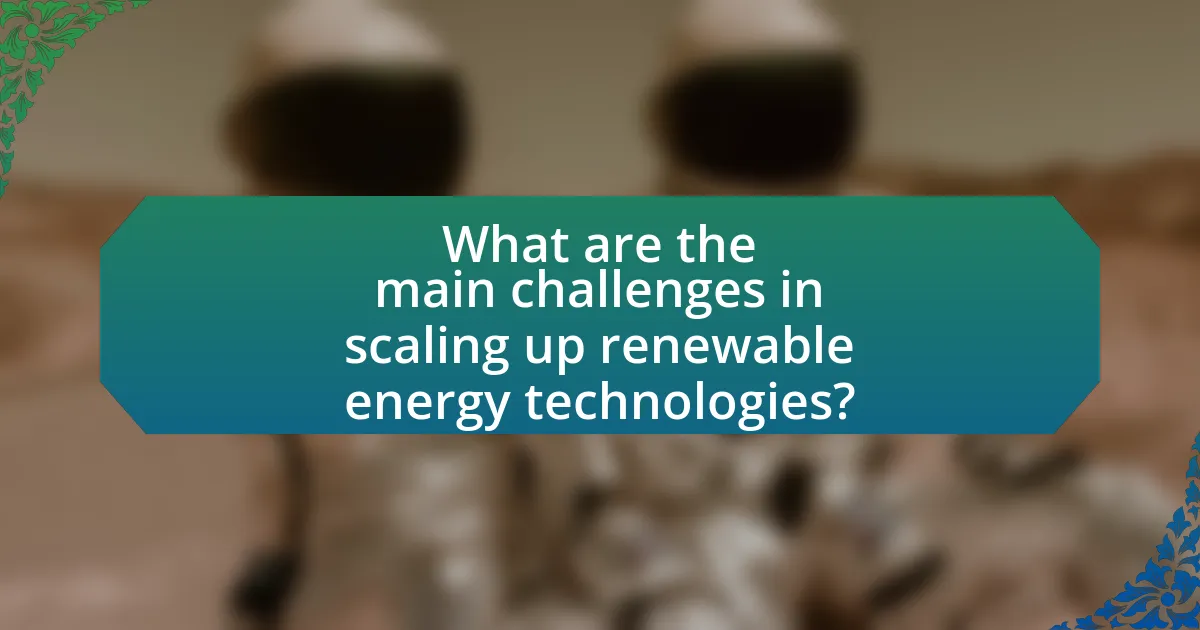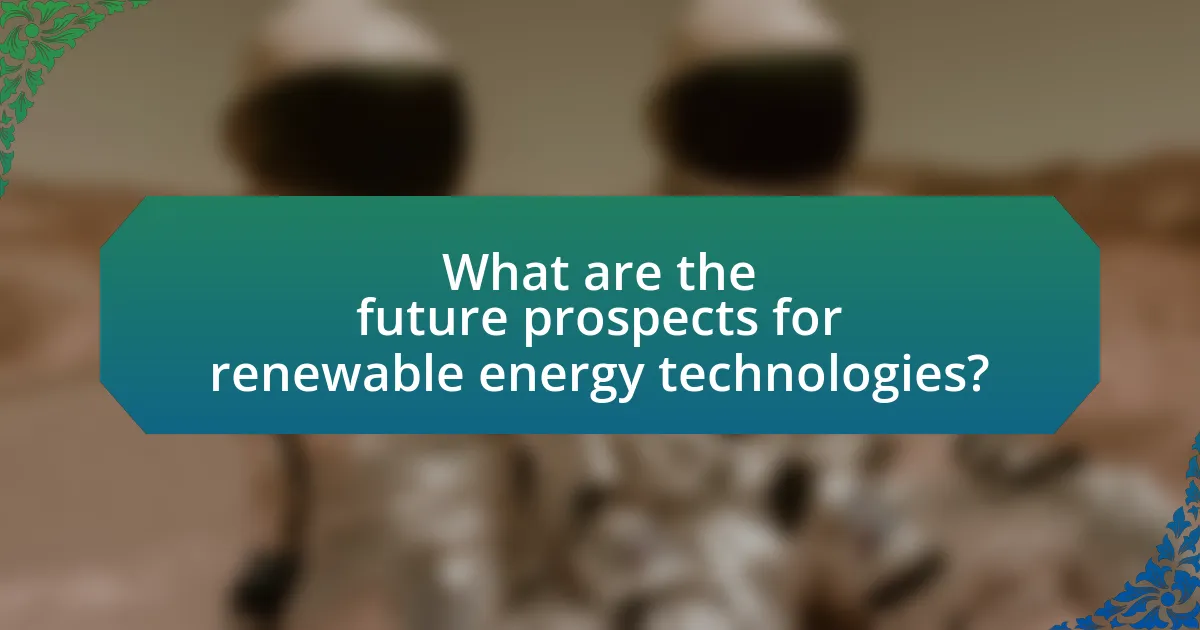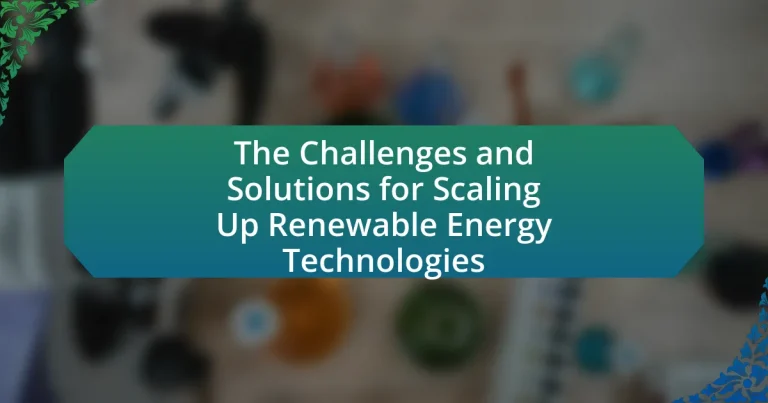The article addresses the challenges and solutions for scaling up renewable energy technologies, focusing on key obstacles such as high initial capital costs, technological limitations, and regulatory barriers. It examines how economic factors, market fluctuations, and technical barriers impact the adoption of renewable energy, alongside the role of government incentives and policy consistency. Additionally, the article highlights innovative financing models, technological advancements, and the importance of public-private partnerships in overcoming these challenges. It concludes with insights on future prospects for renewable energy technologies and the role of consumers in driving market demand.

What are the main challenges in scaling up renewable energy technologies?
The main challenges in scaling up renewable energy technologies include high initial capital costs, technological limitations, and regulatory barriers. High initial capital costs hinder investment in renewable projects, as seen in solar and wind energy installations, which require significant upfront funding. Technological limitations, such as energy storage and grid integration, restrict the efficiency and reliability of renewable sources, impacting their widespread adoption. Regulatory barriers, including inconsistent policies and lack of incentives, create uncertainty for investors and developers, further complicating the scaling process. These challenges collectively impede the transition to a more sustainable energy system.
How do economic factors impact the scalability of renewable energy technologies?
Economic factors significantly influence the scalability of renewable energy technologies by affecting investment levels, cost structures, and market demand. High initial capital costs can deter investment in renewable projects, while economies of scale can reduce costs as production increases, making technologies more accessible. For instance, the International Renewable Energy Agency reported that the cost of solar photovoltaic systems fell by 82% between 2010 and 2019, driven by increased production and technological advancements. Additionally, government policies and incentives, such as tax credits and subsidies, can enhance the financial viability of renewable energy projects, thereby promoting scalability.
What role do initial investment costs play in the adoption of renewable energy?
Initial investment costs significantly influence the adoption of renewable energy by acting as a primary barrier for both individuals and organizations. High upfront costs associated with technologies such as solar panels, wind turbines, and energy storage systems can deter potential adopters, despite the long-term savings and environmental benefits. For instance, a study by the International Renewable Energy Agency (IRENA) found that the initial capital required for solar photovoltaic systems can be a major obstacle, particularly in developing countries where financing options are limited. This financial barrier often leads to slower adoption rates, as stakeholders weigh the immediate costs against future returns on investment.
How do market fluctuations affect renewable energy technology scaling?
Market fluctuations significantly impact the scaling of renewable energy technologies by influencing investment levels, project financing, and technology adoption rates. When market conditions are favorable, such as during periods of high energy prices or government incentives, investments in renewable technologies tend to increase, leading to accelerated scaling. For instance, the International Renewable Energy Agency reported that global investment in renewable energy reached $282 billion in 2019, driven by favorable market conditions. Conversely, during economic downturns or periods of low fossil fuel prices, investments may decline, slowing the deployment of renewable technologies. This relationship is evident in the 2020 pandemic, where global renewable energy investments fell by 20% due to market instability. Thus, market fluctuations directly affect the financial viability and growth trajectory of renewable energy technologies.
What technical barriers hinder the scaling of renewable energy technologies?
Technical barriers that hinder the scaling of renewable energy technologies include limitations in energy storage, grid integration challenges, and high initial costs. Energy storage technologies, such as batteries, often lack the capacity and efficiency needed to store large amounts of renewable energy for extended periods, which is crucial for balancing supply and demand. Grid integration challenges arise from the intermittent nature of renewable sources like solar and wind, requiring advanced grid management systems to ensure reliability and stability. Additionally, high initial costs for renewable energy infrastructure can deter investment, despite decreasing costs over time. For instance, a report by the International Renewable Energy Agency (IRENA) highlights that while the cost of solar photovoltaics has dropped by over 80% since 2010, the upfront investment remains a significant barrier for widespread adoption.
How does technology maturity influence scalability?
Technology maturity significantly influences scalability by determining the readiness and reliability of a technology for widespread deployment. Mature technologies, such as solar photovoltaic systems, have undergone extensive testing and optimization, resulting in established manufacturing processes and supply chains that facilitate large-scale production. For instance, the International Renewable Energy Agency reported that the cost of solar energy has decreased by 89% since 2009 due to advancements in technology maturity, enabling broader adoption and scalability. In contrast, emerging technologies may face challenges such as higher costs, unproven performance, and limited infrastructure, which can hinder their scalability. Thus, the level of maturity directly impacts the feasibility and speed at which renewable energy technologies can be scaled up.
What are the challenges related to energy storage and grid integration?
The challenges related to energy storage and grid integration include technological limitations, economic factors, and regulatory hurdles. Technological limitations arise from the current inefficiencies in energy storage systems, such as lithium-ion batteries, which can degrade over time and have limited capacity. Economic factors involve the high initial costs of deploying advanced storage solutions and the need for significant investment in grid infrastructure to accommodate variable renewable energy sources. Regulatory hurdles include outdated policies that do not incentivize the integration of storage technologies into existing grid systems, hindering their widespread adoption. These challenges collectively impede the transition to a more resilient and sustainable energy grid.
What regulatory and policy challenges exist for renewable energy technologies?
Regulatory and policy challenges for renewable energy technologies include inconsistent regulations, lack of supportive policies, and complex permitting processes. Inconsistent regulations across different jurisdictions can create uncertainty for investors and developers, hindering project financing and implementation. Additionally, the absence of comprehensive policies that promote renewable energy adoption, such as feed-in tariffs or tax incentives, limits market growth. Complex permitting processes can delay project timelines and increase costs, further discouraging investment in renewable technologies. These challenges are evidenced by studies indicating that regulatory uncertainty is a significant barrier to the deployment of renewable energy projects, as highlighted in the International Renewable Energy Agency’s report on renewable energy deployment barriers.
How do government incentives impact the growth of renewable energy sectors?
Government incentives significantly accelerate the growth of renewable energy sectors by providing financial support and reducing investment risks. For instance, tax credits, grants, and subsidies lower the cost of renewable energy projects, making them more attractive to investors. According to the International Renewable Energy Agency (IRENA), countries that implemented strong policy frameworks and incentives saw a 50% increase in renewable energy capacity from 2010 to 2020. Furthermore, the U.S. solar market grew by 167% between 2010 and 2015, largely due to the federal Investment Tax Credit (ITC) that incentivized solar installations. These incentives not only stimulate market demand but also foster innovation and technological advancements within the sector.
What are the implications of inconsistent policies on renewable energy scaling?
Inconsistent policies on renewable energy scaling lead to market uncertainty, reduced investment, and hindered technological advancement. When governments fail to provide stable and predictable regulatory frameworks, investors are less likely to commit capital to renewable energy projects, as evidenced by a report from the International Renewable Energy Agency (IRENA) which highlights that policy instability can decrease investment by up to 50%. Furthermore, inconsistent policies can result in fragmented markets, making it difficult for companies to scale operations efficiently. This fragmentation can slow down the deployment of renewable technologies, as seen in regions where policy shifts have led to abrupt changes in incentives, causing project delays and cancellations. Overall, the lack of coherent policies undermines the growth potential of the renewable energy sector.

What solutions can be implemented to overcome these challenges?
To overcome the challenges of scaling up renewable energy technologies, governments and organizations can implement policies that promote investment in research and development. These policies can include tax incentives, grants, and subsidies aimed at reducing the financial risks associated with new technologies. For instance, the International Renewable Energy Agency reported that global investment in renewable energy reached $282 billion in 2019, demonstrating the effectiveness of financial incentives in driving growth in this sector. Additionally, enhancing grid infrastructure to accommodate renewable energy sources can mitigate integration challenges, as evidenced by successful projects in countries like Germany, where grid upgrades have facilitated a significant increase in renewable energy share.
How can financial mechanisms support the scaling of renewable energy technologies?
Financial mechanisms can support the scaling of renewable energy technologies by providing necessary funding, reducing investment risks, and facilitating access to capital. For instance, mechanisms such as feed-in tariffs and power purchase agreements guarantee fixed prices for renewable energy, which encourages investment by ensuring predictable revenue streams. Additionally, green bonds and climate finance initiatives mobilize private capital by offering lower interest rates and favorable terms for renewable projects. According to the International Renewable Energy Agency, investments in renewable energy reached $282 billion in 2019, demonstrating the effectiveness of these financial tools in driving growth in the sector.
What innovative financing models are being used to promote renewable energy?
Innovative financing models promoting renewable energy include green bonds, power purchase agreements (PPAs), and crowdfunding platforms. Green bonds allow investors to fund projects specifically aimed at environmental benefits, with the global green bond market reaching over $1 trillion in issuance by 2021. Power purchase agreements enable long-term contracts between energy producers and consumers, providing stable revenue streams that attract investment; for instance, the U.S. solar market has seen significant growth through PPAs, accounting for over 60% of new solar capacity in recent years. Crowdfunding platforms democratize investment in renewable projects, allowing individuals to contribute to local energy initiatives, with platforms like Solar Mosaic raising millions for solar installations. These models collectively enhance access to capital, reduce financial risks, and accelerate the deployment of renewable energy technologies.
How can public-private partnerships enhance investment in renewable energy?
Public-private partnerships can enhance investment in renewable energy by leveraging the strengths of both sectors to mobilize resources, share risks, and accelerate project development. These partnerships enable governments to provide regulatory support and financial incentives, while private companies contribute capital, innovation, and operational expertise. For instance, the International Renewable Energy Agency reported that such collaborations can lead to increased funding for renewable projects, as seen in the $1.5 billion investment in solar energy initiatives in India, facilitated by partnerships between the government and private firms. This synergy not only boosts investment but also fosters technological advancements and improves project viability, ultimately driving the transition to sustainable energy sources.
What technological advancements can facilitate the scaling of renewable energy?
Technological advancements such as energy storage systems, smart grid technology, and advanced photovoltaic materials can significantly facilitate the scaling of renewable energy. Energy storage systems, like lithium-ion batteries, enable the storage of excess energy generated during peak production times, allowing for a more reliable energy supply when demand is high. Smart grid technology enhances the efficiency of energy distribution by optimizing the flow of electricity and integrating various energy sources, which is crucial for managing the variability of renewable energy. Advanced photovoltaic materials, including perovskite solar cells, offer higher efficiency rates and lower production costs, making solar energy more accessible and economically viable. These advancements collectively address the challenges of intermittency, distribution efficiency, and cost-effectiveness in renewable energy deployment.
How can improvements in energy storage technology aid scalability?
Improvements in energy storage technology can significantly aid scalability by enabling the efficient integration of renewable energy sources into the grid. Enhanced storage solutions, such as advanced lithium-ion batteries and solid-state batteries, allow for the capture and retention of excess energy generated during peak production times, which can then be utilized during periods of low generation. For instance, the International Renewable Energy Agency (IRENA) reported that energy storage capacity could increase by up to 1,000 gigawatts by 2030, facilitating a more reliable and flexible energy supply. This capability not only stabilizes the grid but also encourages investment in renewable technologies, as the risk of energy supply fluctuations is mitigated.
What role does digital technology play in optimizing renewable energy systems?
Digital technology plays a crucial role in optimizing renewable energy systems by enhancing efficiency, reliability, and integration. Advanced data analytics and machine learning algorithms enable real-time monitoring and predictive maintenance of renewable energy assets, such as wind turbines and solar panels, which can lead to a reduction in downtime and operational costs. For instance, a study by the International Renewable Energy Agency (IRENA) indicates that digital technologies can improve the efficiency of solar photovoltaic systems by up to 20% through better performance monitoring and fault detection. Additionally, digital platforms facilitate the integration of renewable energy sources into existing power grids, allowing for better demand response and energy management, which is essential for balancing supply and demand in a renewable-heavy energy landscape.
How can policy reforms drive the growth of renewable energy technologies?
Policy reforms can drive the growth of renewable energy technologies by creating a supportive regulatory environment that incentivizes investment and innovation. For instance, governments can implement feed-in tariffs, tax credits, and renewable portfolio standards that encourage the adoption of renewable energy sources. According to the International Renewable Energy Agency (IRENA), countries that have enacted such policies have seen significant increases in renewable energy capacity; for example, Germany’s feed-in tariff policy led to a tenfold increase in solar energy capacity from 2000 to 2015. These reforms not only lower the financial barriers for developers but also stimulate job creation and technological advancements in the renewable sector.
What best practices can governments adopt to create a supportive regulatory environment?
Governments can adopt best practices such as establishing clear and consistent policies, engaging stakeholders, and providing financial incentives to create a supportive regulatory environment for renewable energy technologies. Clear policies, such as renewable energy targets and streamlined permitting processes, help reduce uncertainty for investors and developers. Engaging stakeholders, including industry experts and local communities, fosters collaboration and ensures that regulations meet practical needs. Financial incentives, such as tax credits and grants, can stimulate investment and innovation in renewable energy sectors. These practices have been shown to enhance the growth of renewable energy markets, as evidenced by countries like Germany and Denmark, which have successfully scaled up their renewable energy capacities through supportive regulatory frameworks.
How can international cooperation enhance renewable energy technology scaling?
International cooperation can enhance renewable energy technology scaling by facilitating knowledge sharing, pooling resources, and harmonizing regulations across borders. Collaborative initiatives, such as the International Renewable Energy Agency (IRENA), enable countries to exchange best practices and innovative technologies, which accelerates the adoption of renewable solutions. For instance, the Global Wind Energy Council reported that international partnerships have led to a 20% increase in wind energy capacity in participating countries. Additionally, joint funding mechanisms, like the Green Climate Fund, provide financial support for large-scale renewable projects, making them more feasible and attractive for investment. This collaborative approach not only reduces costs but also fosters a unified regulatory framework, which simplifies the deployment of renewable technologies globally.

What are the future prospects for renewable energy technologies?
The future prospects for renewable energy technologies are highly promising, driven by advancements in efficiency, cost reduction, and supportive policies. The International Renewable Energy Agency (IRENA) projects that renewable energy could supply up to 86% of global power needs by 2050, significantly reducing greenhouse gas emissions. Additionally, the cost of solar photovoltaic systems has decreased by over 80% since 2010, making them increasingly competitive with fossil fuels. Furthermore, innovations in energy storage and grid integration are enhancing the reliability and scalability of renewable energy sources, facilitating their adoption across various sectors.
How is the global market for renewable energy technologies expected to evolve?
The global market for renewable energy technologies is expected to grow significantly, driven by increasing demand for clean energy and supportive government policies. According to a report by the International Renewable Energy Agency (IRENA), the renewable energy sector could attract investments exceeding $2 trillion annually by 2030, reflecting a compound annual growth rate of around 8% from 2020 levels. This growth is fueled by advancements in technology, decreasing costs of solar and wind energy, and a global shift towards sustainability in response to climate change.
What trends are shaping the future of renewable energy adoption?
The future of renewable energy adoption is being shaped by several key trends, including technological advancements, policy support, and increasing consumer demand for sustainable solutions. Technological advancements, such as improvements in solar panel efficiency and energy storage systems, are making renewable energy more accessible and cost-effective. For instance, the International Renewable Energy Agency reported that the cost of solar photovoltaic systems has dropped by 82% since 2010, significantly boosting adoption rates.
Policy support, including government incentives and international agreements like the Paris Agreement, is driving investment in renewable energy infrastructure. According to the Global Wind Energy Council, global wind capacity reached 743 GW in 2020, reflecting strong policy frameworks that encourage renewable energy development.
Additionally, consumer demand for clean energy is rising, with a growing number of individuals and businesses seeking to reduce their carbon footprints. A 2021 survey by the Pew Research Center found that 79% of Americans support expanding solar panel farms, indicating a strong public preference for renewable energy sources. These trends collectively indicate a robust trajectory toward increased renewable energy adoption.
How can emerging markets leverage renewable energy technologies for growth?
Emerging markets can leverage renewable energy technologies for growth by investing in solar, wind, and biomass energy sources to enhance energy access and reduce dependency on fossil fuels. These technologies can provide affordable and sustainable energy solutions, which are crucial for economic development. For instance, according to the International Renewable Energy Agency (IRENA), renewable energy could create up to 24 million jobs globally by 2030, significantly benefiting emerging economies. Additionally, the deployment of renewable energy can attract foreign investment, as seen in countries like India, where solar energy initiatives have drawn billions in investments, fostering economic growth and technological innovation.
What role do consumers play in the scaling of renewable energy technologies?
Consumers play a crucial role in the scaling of renewable energy technologies by driving demand and influencing market dynamics. Their adoption of renewable energy solutions, such as solar panels and electric vehicles, creates a significant market for these technologies, encouraging manufacturers to innovate and reduce costs. For instance, a report from the International Renewable Energy Agency (IRENA) indicates that consumer demand has led to a 90% reduction in the cost of solar photovoltaic systems since 2010. Additionally, consumers’ willingness to invest in renewable energy not only accelerates deployment but also fosters policy changes that support sustainable energy initiatives. This collective consumer behavior ultimately shapes the energy market, making renewable technologies more accessible and viable on a larger scale.
How can consumer awareness and demand influence renewable energy markets?
Consumer awareness and demand significantly influence renewable energy markets by driving investment and innovation in sustainable technologies. When consumers prioritize renewable energy, they create a market demand that encourages companies to develop and offer cleaner energy solutions. For instance, a 2021 survey by the International Renewable Energy Agency found that 70% of consumers are willing to pay a premium for renewable energy, indicating a strong preference that can lead to increased market share for green energy providers. This heightened demand can also prompt governments to implement supportive policies and incentives, further accelerating the transition to renewable energy sources.
What are the implications of decentralized energy systems for consumers?
Decentralized energy systems empower consumers by providing greater control over their energy sources and consumption. These systems enable individuals and communities to generate, store, and manage their own energy, often leading to reduced reliance on traditional utility providers. For instance, a study by the International Renewable Energy Agency (IRENA) highlights that decentralized systems can lower energy costs by up to 30% for consumers, as they can utilize local renewable resources like solar or wind energy. Additionally, consumers benefit from increased energy resilience, as decentralized systems can operate independently during grid outages, enhancing energy security.
What practical steps can stakeholders take to support renewable energy scaling?
Stakeholders can support renewable energy scaling by investing in research and development to enhance technology efficiency and reduce costs. For instance, the International Renewable Energy Agency reported that global investment in renewable energy reached $282 billion in 2019, demonstrating the financial commitment necessary for innovation. Additionally, stakeholders should advocate for supportive policies and regulations that incentivize renewable energy adoption, such as tax credits and feed-in tariffs, which have been shown to significantly increase deployment rates. Collaboration among governments, private sectors, and communities is essential to create a robust infrastructure that facilitates the integration of renewable energy sources into existing grids. Furthermore, stakeholders can engage in public awareness campaigns to educate consumers about the benefits of renewable energy, which can drive demand and acceptance.
What strategies can businesses implement to adopt renewable energy technologies?
Businesses can adopt renewable energy technologies by implementing strategies such as conducting energy audits, investing in renewable energy sources, and forming partnerships with energy providers. Conducting energy audits allows businesses to identify energy consumption patterns and areas for improvement, which can lead to targeted investments in solar, wind, or other renewable technologies. Investing in renewable energy sources not only reduces reliance on fossil fuels but can also lead to long-term cost savings; for instance, the International Renewable Energy Agency reported that solar energy costs have dropped by 89% since 2009. Forming partnerships with energy providers can facilitate access to renewable energy solutions and financing options, enabling businesses to transition more effectively.
How can individuals contribute to the growth of renewable energy solutions?
Individuals can contribute to the growth of renewable energy solutions by adopting sustainable practices, such as using energy-efficient appliances, supporting local renewable energy projects, and advocating for policies that promote clean energy. For instance, according to the International Renewable Energy Agency, individual actions can significantly reduce household energy consumption, leading to lower carbon emissions. Additionally, individuals can invest in renewable energy sources like solar panels for their homes, which not only decreases reliance on fossil fuels but also supports the renewable energy market. Engaging in community initiatives, such as participating in local clean energy campaigns or educational programs, further amplifies the impact of individual contributions to the renewable energy sector.




